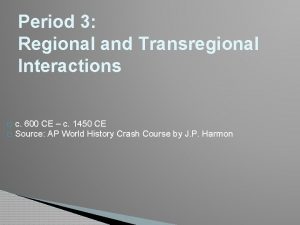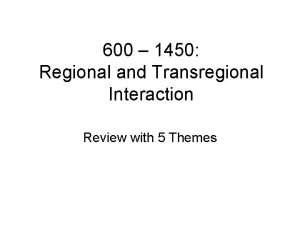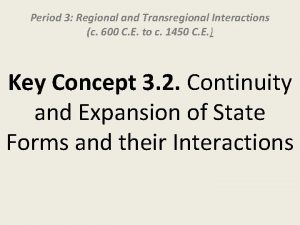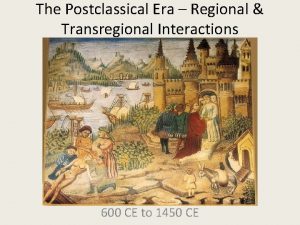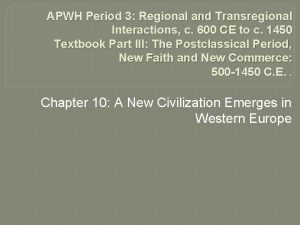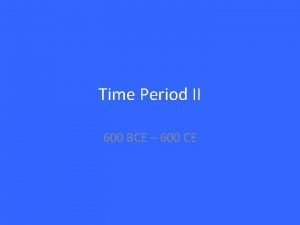Period 3 Regional and Transregional Interactions c 600










- Slides: 10

Period 3. • Regional and Transregional Interactions, c. 600 C. E. to c. 1450

Key Concepts • Key Concept 3. 1. Expansion and Intensification of Communication and Exchange Networks. • Key Concept 3. 2. Continuity and Innovation of State Forms and Their Interactions. • Key Concept 3. 3. Increased Economic Productive Capacity and Its Consequences

Essential Questions. • What continuity and innovations of state forms and their interactions occurred during this period of time.

II. The movement of peoples caused environment and linguistic effects. • A. The expansion and intensification of long-distance trade routes often depended on environmental knowledge and technological adaptation to it. i. Environmental knowledge and technological adaptations occurred in a. the way Scandinavian Vikings used their longships to travel in coastal and open waters as well as in rivers and estuarties. b. the way the Arabs and Berbers adapted camels to travel across and around the Sahara. c. the way Central Asian pastoral groups used horses to travel in the steppes.

II. The movement of peoples caused environment and linguistic effects. B. Some Migration had a significant environmental impact. 1. The migration of the Bantu-speaking peoples who facilitated transmission of iron technologies and agricultural techniques in Sub-Saharan Africa. 2. The Maritime migration of the Polynesian people who cultivated transplanted foods and domesticated animals as they moved to new Islands.

II. The movement of peoples caused environment and linguistic effects. C. Some migration and commercial contacts led to the diffusion of languages throughout a new region or the emergence of new languages. 1. the spread of Bantu languages including the Swahili. 2. The spread of Turkic and Arabic Languages.

II. Africa’s Geography A. large size a. three times the size of the United States. b. locations led to a wide variety of climates & vegetation. c. distinct cultures and ways of life developed. B. Climate zones a. Rain forest: only around the equator. b. savanna. (grassy plain), the most populated. c. steppe zone. d. two deserts: i. Sahara to the north. ii. The Kalahari and Namib in the South.

III. The Bantu Migrations A. Changing Sahara a. desertification b. migration. B. Bantu Migration contributed to the diversity & cultures of Africa. a. Migration was south and southeast. b. Farmers & Herders migrated south and East between 1000 BCE to 1000 CE. c. Migrators spoke a variety of languages from a root common language. (more than 2000 dialects). d. Cultural development i. some nomadic herders. ii. some settled farmers.


TOTD • In a paragraph and without notes. • Explain the topic covered today in class.
 Regional and transregional interactions
Regional and transregional interactions Regional and transregional interactions
Regional and transregional interactions Trigonometri
Trigonometri Refractory period
Refractory period Absolute refractory period and relative refractory period
Absolute refractory period and relative refractory period Trustee period and royal period
Trustee period and royal period Paleolithic age time period
Paleolithic age time period Interactions between ais and internal and external parties
Interactions between ais and internal and external parties Critical period vs sensitive period
Critical period vs sensitive period Critical period vs sensitive period
Critical period vs sensitive period Critical period
Critical period
